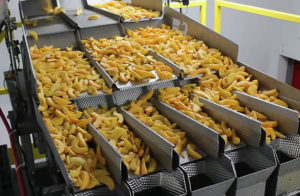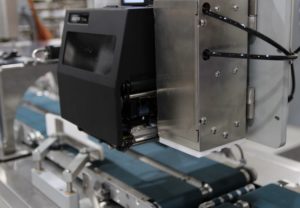Weighing equipment can bring balance to the bottom line
If there’s one lesson that COVID-19 has taught us it’s that flexibility will be one of our greatest tools going forward. The pandemic has presented labor complications and created volatility in terms of consumer demand.
As a result, processors have had to find ways to respond quickly, sometimes with minimal staff, all while maintaining high food safety standards and reducing waste. Those challenges have been enormous. Three companies explain how weighing equipment can bring balance to your bottom line.
Heat and Control, Ishida address processing trends
According to Brian Barr, director of sales at Heat and Control, there are two big trends in food processing right now: automation and flexibility. Processors, he said, are looking for more flexible, long-term solutions and ways to reduce labor.
When it comes to weighing equipment, Ishida is an industry leader. The Japanese family-owned company has been in operation since 1893. The California-based Heat and Control partnered with Ishida 40 years ago. Heat and Control is a food processing equipment manufacturer that provides solutions both up and downstream, including handling, processing and packaging equipment. Barr says they entered into a relationship with Ishida because of their superior weighing technology.
The keys to quality weighing equipment in fast-paced processing plants are accuracy, efficiency and repeatability.
“If they are selling a 12-ounce bag of cut vegetables, they are minimizing any giveaway but also ensuring that they’re meeting all of their label weights going into their further processing lines,” Barr explained.
Labor has been unreliable since the pandemic hit, which is why processors are looking to automation for solutions. Specifically, they’re looking for easy-to-use equipment that can be quickly, simply and thoroughly sanitized between workloads.
Today’s processors are also looking for equipment that provides flexibility in the long term, said Barr. Product mixes and SKUs change frequently based on consumer demand. They’re looking for the flexibility to run a variety of products on the same line with quick and easy changeovers.
When it comes to combination weighers, Barr said the company prides itself on having a solution for every customer. One of its most popular solutions is Ishida’s CCW-RV Series multihead weigher, which combines accuracy, flexibility and sanitation. It’s the only weigher in the market that has IP ratings of 66, 67 and 69K. Equipment with an IP rating of 69K is able to withstand high temperature and high-pressure washdown.
“It provides them with a much more sanitary and robust machine to be able to handle the environments in which they operate,” he said.
While sanitation and weighing accuracy are crucial, processors need equipment that can transfer product of any configuration to the scale without damaging it. This is where Heat and Control comes in. The company specializes in delivering product to the weigher and discharging it further down the line to packaging.
The typical lifespan of an Ishida combination weigher is anywhere from 15-25 years, said Barr. But as demand changes, equipment sometimes outlasts products. By working closely with their customers, Barr said they’re able to find solutions that will last into the long term. Currently, he said, customers are focused on just trying to keep up with demand and address changes, such as switching from the food services sector to the retail market.
Triangle Packaging in-line combination scale offers improved accuracy
Ideal for a variety of food packaging applications, including IQF and semi-moist products, Triangle Packaging Machinery’s in-line combination weighers are designed to improve accuracy, said VP of Business Development Paul Muskat.

Weighers come in two base models — Model A612 and Model A918 — and feature three methods for feeding product: vibratory trays, a hopper or a unique belt-fed system, which is the most suitable option for fresh products.
The in-line models ensure product distribution and weight accuracy, said Muskat, as well as a multiple-product blending option that enables up to 2,000 combinations (with the A918 model).
“But the key factor to every combination weigher is the in-feed,” said Muskat.
“You have your 18 combinations … if you do not get product to one of those, your combinations drop by 50% and your giveaway can double.”
“It’s very critical to feed the correct amount to every combination available,” he added. “Our in-line scale is a lot more efficient in providing product to a combination weigher, especially for broccoli or something that is hard to feed.”
Muskat pointed to other ingredients that could benefit from in-line weighing, including garlic and chicken. Too much or too little garlic could ruin a dish, and accurately weighing high-cost ingredients like chicken saves money, he said. Accurate weighing is also needed to match caloric and nutritional labeling requirements.
Triangle Packaging offers two in-line weighing solutions. Model A612 features 12 selection buckets and has a maximum speed of 135 discharges per minute. Model A918 has 18 selection buckets and has a maximum speed of up to 165 discharges per minute.
Both designs feature quick, hand-removable components for easy accessibility and sanitation, and are available in smooth or Rigid-Tex finish to ensure continuous product flow.
Weigh price labeler increases flexibility in tough times
At the retail level, COVID-19 has brought about further challenges, some of which can be addressed by weigh price labeling equipment. Jason Angel, vice president of sales and marketing at ProMach, the parent company for Ossid brand, explains.

Weigh price labeling equipment is exactly what it sounds like: it weighs, calculates price, and then labels product packaged in overwrapped trays or cases. Processors use weigh price labeling equipment to get away from fixed weight packaging.
“It allows them to have a more defined weight on the package so they’re not giving away product,” said Angel.
They’re also used to reduce labor, as label application has often been done through manual labor. This is especially important during the current crisis, as it allows processors to increase throughput without having to hire more employees.
But current trends at the retail level reveal that consumers are more interested in purchasing healthier food. This includes processed products such as cut vegetables, sliced mushrooms and cubed squash.
But more and more, consumers are seeking fruits and vegetables that, traditionally speaking, are not packaged. Since the pandemic began, Angel says consumers are more interested in purchasing packaged products that are protected from multiple hands than loose product. This means more throughputs, which means more labor and greater potential loss. Weigh price labelers like Ossid’s 1500 Series can eliminate both challenges in one.
Processors who have invested in Ossid’s weigh price labeler are attracted to some of its other features as well, including its use of non-proprietary components. The machines are customizable and American made, said Angel.
(Top Photo: An Ishida CCW weigher, available through Heat and Control, doles out mixed salad greens.)







